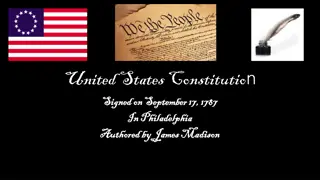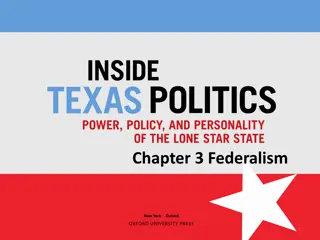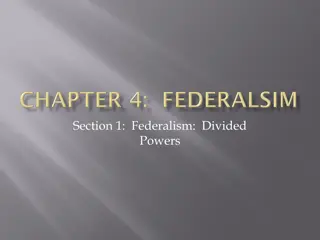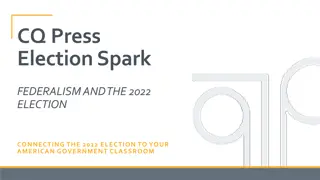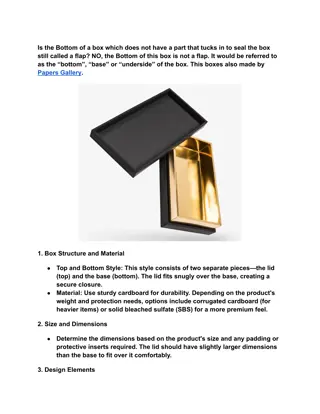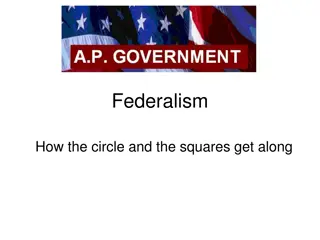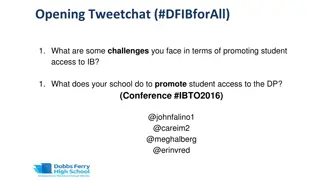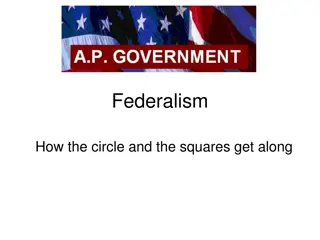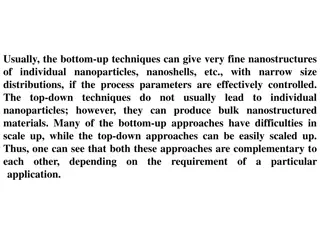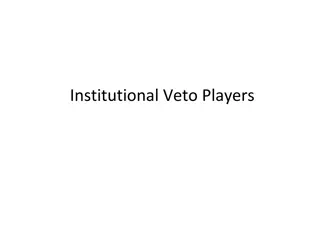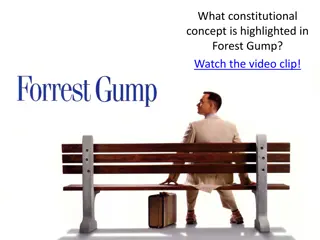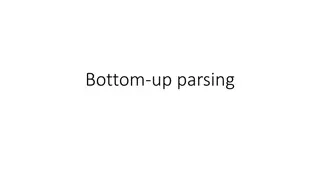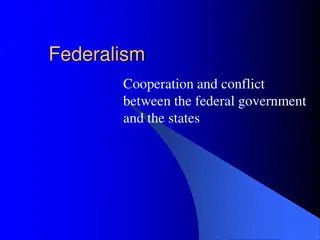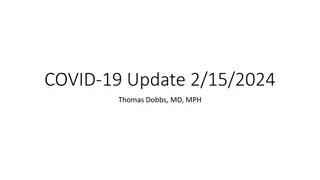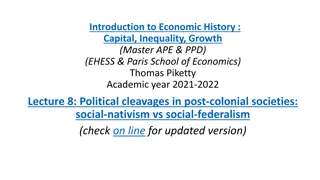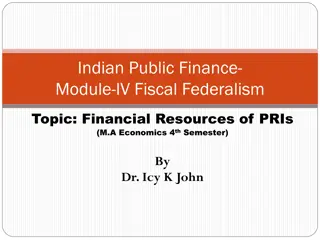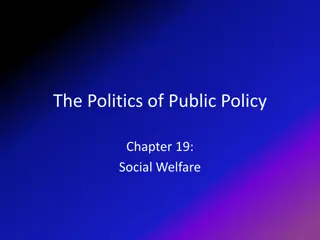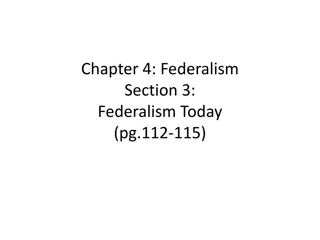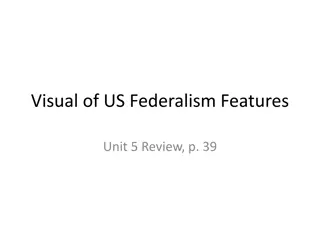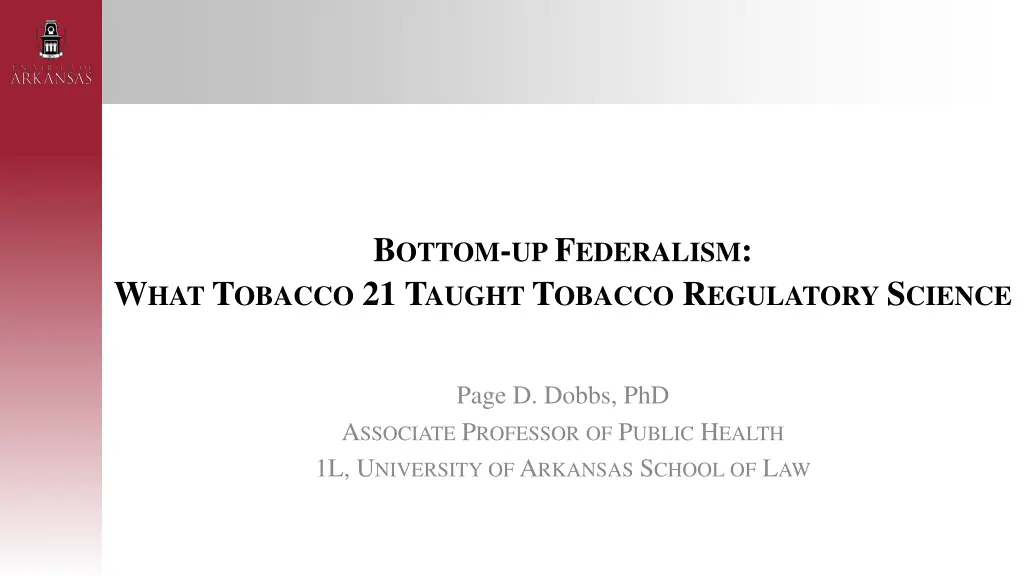
Insights on Tobacco 21 Laws from Bottom-Up Federalism Research
Explore the impact of Tobacco 21 laws on public health, supported by strong evidence. Learn about the development of assessment tools for policy analysis in the tobacco regulatory science field, shedding light on effective regulatory strategies for tobacco control.
Download Presentation

Please find below an Image/Link to download the presentation.
The content on the website is provided AS IS for your information and personal use only. It may not be sold, licensed, or shared on other websites without obtaining consent from the author. If you encounter any issues during the download, it is possible that the publisher has removed the file from their server.
You are allowed to download the files provided on this website for personal or commercial use, subject to the condition that they are used lawfully. All files are the property of their respective owners.
The content on the website is provided AS IS for your information and personal use only. It may not be sold, licensed, or shared on other websites without obtaining consent from the author.
E N D
Presentation Transcript
BOTTOM-UPFEDERALISM: WHAT TOBACCO 21 TAUGHT TOBACCO REGULATORY SCIENCE Page D. Dobbs, PhD ASSOCIATE PROFESSOR OF PUBLIC HEALTH 1L, UNIVERSITY OFARKANSAS SCHOOL OF LAW
Conflicts of Interest Completing legal externship with Truth Initiative, Schroeder Institute and Campaign for Tobacco Free Kids during Summer 2025
Tobacco 21 Laws that raise the legal minimum sales age (MLSA) to 21 year Strong Public Support (Lee et al., 2016; King et al., 2015; Volinsky et al., 2018; Winickoff et al., 2016; Zhang et al., 2018) Decreases tobacco initiation among 15-17-year-olds by 25% (Bonnie et al., 2015) Reduces smoking rates among: Adults by 12% (Bonnie et al., 2015) 18-20-year old young adults (Friedman & Wu, 2019) 18-20-year-olds who have used cigarettes by 39% (Friedman et al., 2019)
Tobacco 21 Assessment Tool Development Tobacco 21 Summit October 2017 Dobbs, P. D. , Chadwick, G., Ungar, K. W., Dunlap, C. M., White, K. A., Kelly, M. C. T., Cheney, M. K. (In press). Development of a tobacco 21 policy assessment tool and state-level analysis in the USA, 2015-2019. Tobacco Control, 1-9.
Tobacco 21 Assessment Tool Development Preliminary Tobacco 21 policy assessment tool developed Literature Review Tobacco 21 Summit Review of current passed policies June 2018 October 2017 Dobbs, P. D. , Chadwick, G., Ungar, K. W., Dunlap, C. M., White, K. A., Kelly, M. C. T., Cheney, M. K. (In press). Development of a tobacco 21 policy assessment tool and state-level analysis in the USA, 2015-2019. Tobacco Control, 1-9.
Tobacco 21 Assessment Tool Development Minor Tool revision based on feedback Minor Revision for item order and wording revisions for question wording and response categories Minor wording revisions and clarifications Preliminary Tobacco 21 policy assessment tool developed Literature Review Feedback from subject matter experts Review by Tobacco 21 Research Team Legal review by attorney Test tool with a sample of policies Tobacco 21 Summit Final review and approval Review of current passed policies June 2018 October 2017 October 2018 Dobbs, P. D. , Chadwick, G., Ungar, K. W., Dunlap, C. M., White, K. A., Kelly, M. C. T., Cheney, M. K. (In press). Development of a tobacco 21 policy assessment tool and state-level analysis in the USA, 2015-2019. Tobacco Control, 1-9.
Tobacco 21 Assessment Tool Development Minor Tool revision based on feedback Minor Revision for item order and wording Finalized tool used to code state & local policies revisions for question wording and response categories Minor wording revisions and clarifications Preliminary Tobacco 21 policy assessment tool developed Literature Review Feedback from subject matter experts Review by Tobacco 21 Research Team Legal review by attorney Test tool with a sample of policies Tobacco 21 Summit Final review and approval Review of current passed policies June 2018 November 2018 October 2017 October 2018 Dobbs, P. D. , Chadwick, G., Ungar, K. W., Dunlap, C. M., White, K. A., Kelly, M. C. T., Cheney, M. K. (In press). Development of a tobacco 21 policy assessment tool and state-level analysis in the USA, 2015-2019. Tobacco Control, 1-9.
Tobacco 21 Assessment Tool Development Minor Tool revision based on feedback Minor Revision for item order and wording Finalized tool used to code state & local policies revisions for question wording and response categories Minor wording revisions and clarifications Preliminary Tobacco 21 policy assessment tool developed Literature Review Overall, 18 states and 477 local policies coded Feedback from subject matter experts Review by Tobacco 21 Research Team Legal review by attorney Test tool with a sample of policies Tobacco 21 Summit Final review and approval Review of current passed policies April 2020 June 2018 November 2018 October 2017 October 2018 Dobbs, P. D. , Chadwick, G., Ungar, K. W., Dunlap, C. M., White, K. A., Kelly, M. C. T., Cheney, M. K. (In press). Development of a tobacco 21 policy assessment tool and state-level analysis in the USA, 2015-2019. Tobacco Control, 1-9.
Policy Components Policy Indicator Operational definition
Policy Components Policy Indicator Policy Prohibition Operational definition Includes the terms sale/sell, give, distribute, and/or barter
Policy Components Policy Indicator Policy Prohibition Comprehensive Tobacco Product Definition Operational definition Includes the terms sale/sell, give, distribute, and/or barter Products that contain , made , derived from tobacco and/or nicotine Includes ENDS. "Electronic nicotine delivery system" Includes tobacco product "components", "parts", or "accessories" Exempts products authorized for sale as a cessation product, as defined in the Federal Food, Drug, and Cosmetic Act
Policy Components Policy Indicator Policy Prohibition Comprehensive Tobacco Product Definition Operational definition Includes the terms sale/sell, give, distribute, and/or barter Products that contain , made , derived from tobacco and/or nicotine Includes ENDS. "Electronic nicotine delivery system" Includes tobacco product "components", "parts", or "accessories" Exempts products authorized for sale as a cessation product, as defined in the Federal Food, Drug, and Cosmetic Act Requires seller to obtain age verification ID request based on appearance age Appearance age to request for photo identification Age Verification
Policy Components Policy Indicator Policy Prohibition Comprehensive Tobacco Product Definition Operational definition Includes the terms sale/sell, give, distribute, and/or barter Products that contain , made , derived from tobacco and/or nicotine Includes ENDS. "Electronic nicotine delivery system" Includes tobacco product "components", "parts", or "accessories" Exempts products authorized for sale as a cessation product, as defined in the Federal Food, Drug, and Cosmetic Act Requires seller to obtain age verification ID request based on appearance age Appearance age to request for photo identification Sign stating legal age of sale for tobacco products is 21 years Age Verification Signage
Policy Components Policy Indicator Enforcement Operational definition Policy states that enforcement (compliance/inspection) checks will be done Enforcement agency identified in the law Minimum number of inspections per retailer Minimum number of under-age compliance checks/stings per retailer Age of under-age compliance check decoy Provides justification for retail inspections/compliance (e.g., smoking rates, access rates, location, density, demographics) Requires reinspection upon violation Compliance reporting required Includes a Tobacco Retail License (TRL) for vendors Identifies fee for license Requires annual renewal of the license by retailer Enforcement agency/licensing authority sets the license fee
Policy Components Policy Indicator Violations & Penalties Operational definition Monetary non-compliance fine for retailers Enforces Civil or Criminal penalty for retailer Retail penalty/fine structure identified Minimum fine amount for retailer noncompliance Penalty fine amount for first, second, third, and subsequent violations States time period for penalty accrual TRL suspension or revocation States license may be suspended due to repeated violations States license may be revoked due to repeated violations Enforces a monetary non-compliance penalty for the clerk
Policy Components Policy Indicator Education Operational definition Education/Training mentioned in the policy for retailer/clerk/employees Education/Training/communication mentioned in the policy for the general public
Policy Components Policy Indicator Education Operational definition Education/Training mentioned in the policy for retailer/clerk/employees Education/Training/communication mentioned in the policy for the general public State statute includes additional measures, such as: Flavor restrictions Distance restrictions (e.g., from schools) Density restrictions (number of retailers per person) Vending machine restrictions to age 21 Restriction of tobacco sales from pharmacies Additional Restriction Measures
Enforcement Policy Language in Tobacco 21 passed before July 1, 2019
Federal Tobacco 21 Law December 20, 2019, the Appropriations Act established a new Federal minimum legal sale age (MLSA) making it unlawful for any retailer to sell a tobacco product to any person younger than 21 years of age.
FDAs Final Rules (1) reflect the increased minimum age of sale for cigarettes, smokeless tobacco, and covered tobacco products from 18 to 21 years of age; (2) increase the minimum age for verification by means of photographic identification for cigarettes, smokeless tobacco, and covered tobacco products from under the age of 27 to under the age of 30; (3) increase the minimum age of persons who may be present or permitted to enter at any time for facilities that maintain vending machines to sell cigarettes, smokeless tobacco, or covered tobacco products from 18 to 21 years of age; and (4) increase the minimum age of persons who may be present or permitted to enter at any time for facilities that maintain self-service displays to sell cigarettes or smokeless tobacco from 18 to 21 years of age.
FDAs Final Rules (1) reflect the increased minimum age of sale for cigarettes, smokeless tobacco, and covered tobacco products from 18 to 21 years of age; (2) increase the minimum age for verification by means of photographic identification for cigarettes, smokeless tobacco, and covered tobacco products from under the age of 27 to under the age of 30; (3) increase the minimum age of persons who may be present or permitted to enter at any time for facilities that maintain vending machines to sell cigarettes, smokeless tobacco, or covered tobacco products from 18 to 21 years of age; and (4) increase the minimum age of persons who may be present or permitted to enter at any time for facilities that maintain self-service displays to sell cigarettes or smokeless tobacco from 18 to 21 years of age.
FDAs Final Rule But what about state Tobacco 21 laws?
Synar Amendment July 1992, Congress passed the Alcohol, Drug Abuse and Mental Health Administration Reorganization Act included an amendment that required states to enact and enforce MLSA laws. With the increase of the federal MLSA to twenty- one, SAMHSA outlined a three-year transition period for implementation and compliance
Synar Amendment Compliance Rate Goals Use of Funds State Reporting Requirements Confirming Amendments Penalty
Synar Amendment Compliance Rate Goals The Compliance Rate Goals outlined in Implementing the Synar Regulation (revised 2011), requires that each state reduce its [Retail Violation Rate] RVR to 20 percent or less A violation is defined as the fraction (or percentage) of tobacco-selling outlets in a state that are accessible to minors and sell tobacco to them. PL 116-94 does not change the compliance rate goal of 20 percent or less. However, the definition of a violation is expanded to include tobacco-selling outlets in a state that are accessible to anyone under the age of 21.
Synar Amendment Use of Funds The Synar regulation states that states may not use the Block Grant to fund the enforcement of their statute, except that they may expend funds from the primary prevention set-aside of their Block Grant allotment under 45 CFR 96.124(b)(1) for carrying out the administrative aspects of the requirements, such as the development of the sample design and the conducting of the inspections [45 CFR 96.130(j)]. This Revision to Guidance notice clarifies that the prevention set- aside may be used to fund revisions to states Synar programs to comply with PL 116-94.
Synar Amendment State Reporting Requirements The State Reporting Requirements in Implementing the Synar Regulation (revised 2011) outlines that states are required to report their sampling methodology and results of the annual Synar survey as a part of the Annual Synar Report no later than December 31. This includes the state s sampling methodology, Synar survey results, Synar inspection report, and the Synar inspection protocol. This Revision to Guidance notice does not change the requirement to submit an Annual Synar Report, but does require that states revise their methodology, inspection reports, and inspection protocols to include the revised age requirements (under 21). In addition, the Synar survey results must now include results for sales to youth and young adults under the age of 21.
Synar Amendment Conforming Amendments SAMHSA s previously issued 2011 guidance on Implementing the Synar Regulation explains that, for states to be in compliance with the Synar regulations, states must enact a law prohibiting any manufacturer, retailer, or distributor of tobacco products from selling or distributing such products to any individual under age 18. PL 116-94 removes the requirements for enacting state laws. Therefore, states do not need to demonstrate a change in state law to maintain compliance with Synar. However, SAMHSA s 2011 guidance further requires that states enforce underage access laws to a degree that reasonably can be expected to reduce the illegal sale of tobacco products to individuals under age 18. PL 116-94 increases the minimum age to 21. Therefore, states are expected to enforce underage access to reduce the illegal sale of tobacco products to individuals under the age of 21.
Synar Amendment Penalty SAMHSA s 2011 guidance on Implementing the Synar Regulation explains that failure to comply with the requirements of the Synar Regulation can result in a State losing up to 40 percent of its Federal Block Grant funds for substance abuse prevention and treatment. PL 116-94 revises the penalty to up to 10 percent of the SABG and codifies a negotiated alternate penalty. Instead of taking the 10 percent penalty, states that are found out of compliance (report a Retail Violation Rate above 20 percent) may elect to submit a corrective action plan to the Assistant Secretary for Mental Health and Substance Use within 90 days of receipt of notice that they are not in compliance with the Synar regulations, which outlines strategies they will take to reduce the Retail Violation Rate to 20 percent or less. States may not use SABG funds to pay for these activities and must find alternate sources of funds to cover these costs.
Current Agency Limitations Executive Order: Unleashing Prosperity Through Deregulation
Current Agency Limitations Executive Order: Unleashing Prosperity Through Deregulation
PAGE DOBBS, PHD ASSOCIATE PROFESSOROF PUBLIC HEALTH UNIVERSITYOF ARKANSAS PDOBBS@UARK.EDU

